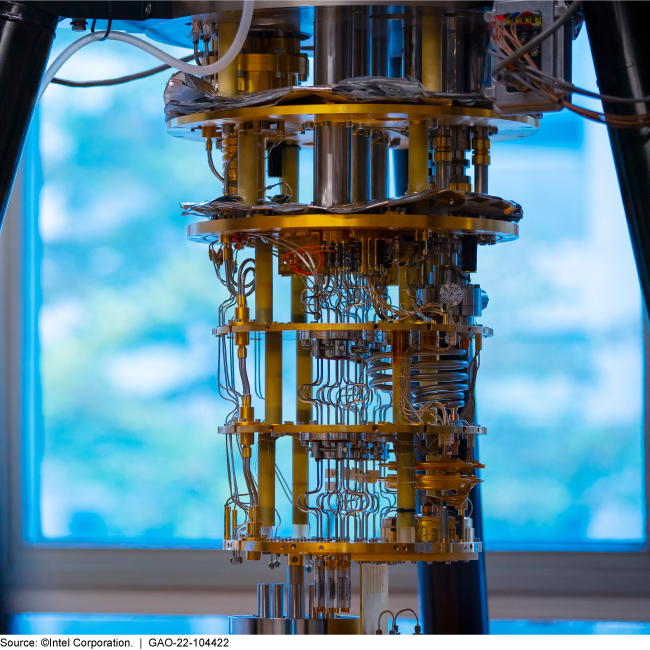Quantum Computing and Communications: Status and Prospects
Fast Facts
Quantum information technologies build on quantum physics to collect, generate, process, and communicate information in ways that existing technologies can't.
This report assesses the potential of these technologies, their benefits and risks, and policy options that could help foster their development.
For example, future quantum computers could outperform regular computers in simulating chemical interactions, potentially reducing drug development time.
Some small, error-prone quantum computers are available, but further development may require collaboration, supply chain and workforce development, and billions of dollars in investments.
Superconducting Quantum Computer Hardware

Highlights
What GAO Found
Quantum information technologies aim to use the properties of nature at atomic scales to accomplish tasks that are not achievable with existing technologies. These technologies rely on qubits, the quantum equivalent of classical computer bits. Scientists are creating qubits from particles, such as atoms or particles of light, or objects that mimic them, such as superconducting circuits. Unlike classical bits, qubits can be intrinsically linked to each other and can be any combination of 0 and 1 simultaneously. These capabilities enable two potentially transformational applications—quantum computing and communications. However, quantum information cannot be copied, is fragile, and can be irreversibly lost, resulting in errors that are challenging to correct.
Examples of quantum computing hardware

Some quantum computing and communications technologies are available for limited uses, but will likely require extensive development before providing significant commercial value. For example, some small error-prone quantum computers are available for limited applications, and a quantum communications technology known as quantum key distribution can be purchased. According to agency officials and stakeholders, additional quantum technology development may take at least a decade and cost billions, but such estimates are highly uncertain. Quantum computing and communications technologies will likely develop together because of some shared physics principles, laboratory techniques, and common hardware.
Quantum computers may have applications in many sectors, but it is not clear where they will have the greatest impact. Quantum communications technologies may have uses for secure communications, quantum networking, and a future quantum internet. Some applications—such as distributed quantum computing, which connects multiple quantum computers together to solve a problem—require both quantum computing and communications technologies. Potential drawbacks of quantum technology include cost, complexity, energy consumption, and the possibility of malicious use.
GAO identified four factors that affect quantum technology development and use: (1) collaboration, (2) workforce size and skill, (3) investment, and (4) the supply chain. The table below describes options that policymakers—legislative bodies, government agencies, standards-setting organizations, industry, and other groups—could consider to help address these factors, enhance benefits, or mitigate drawbacks of quantum technology development and use.
Policy Options to Help Address Factors that Affect Quantum Technology Development and Use, or to Enhance Benefits or Mitigate Drawbacks
|
Policy options and potential implementation approaches |
Opportunities | Considerations |
|
Collaboration (report p. 37)
|
|
|
|
Workforce (report p. 39)
|
|
|
|
Investment (report p. 41)
|
|
|
|
Supply Chain (report p. 43)
|
|
|
Source: GAO. | GAO-21-104422
Why GAO Did This Study
Quantum information technologies could dramatically increase capabilities beyond what is possible with classical technologies. Future quantum computers could have high-value applications in security, cryptography, drug development, and energy. Future quantum communications could allow for secure communications by making information challenging to intercept without the eavesdropper being detected.
GAO conducted a technology assessment on (1) the availability of quantum computing and communications technologies and how they work, (2) potential future applications of such technologies and benefits and drawbacks from their development and use, and (3) factors that could affect technology development and policy options available to help address those factors, enhance benefits, or mitigate drawbacks.
To address these objectives, GAO reviewed key reports and scientific literature; interviewed government, industry, academic representatives, and potential end users; and convened a meeting of experts in collaboration with the National Academies of Sciences, Engineering, and Medicine. GAO is identifying policy options in this report.
For more information, contact Karen L. Howard at (202) 512-6888 or howardk@gao.gov.
